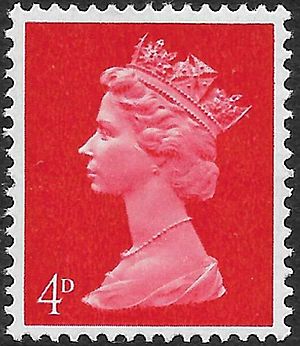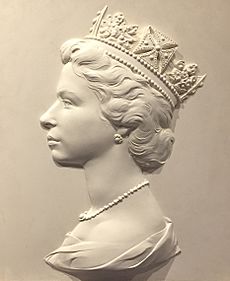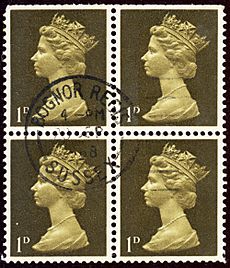Machin series facts for kids
The Machin series of postage stamps is the main set of everyday stamps used in the United Kingdom. These stamps have been used since June 5, 1967. They are the second series of stamps to show a picture of Elizabeth II, taking over from the earlier Wilding series. The last Machin stamp featuring Queen Elizabeth II was released on April 4, 2022.
These stamps were designed by Arnold Machin. They simply show a sculpted side-view of the Queen's head and the stamp's value. They are almost always printed in a single color.
For over 50 years, the Machin series has seen almost every change in how British stamps are printed. This has made them very popular with stamp collectors, who enjoy finding all the different types.
Even though the Queen's picture on British coins was updated in 1984, the picture on Machin stamps was never changed. The Queen herself turned down ideas to update the design.
Contents
How the Machin Stamp Was Created
When Queen Elizabeth II became Queen in 1952, the regular stamps showed a photograph of her. This photo was taken by Dorothy Wilding. However, some artists didn't like this design. They felt it didn't truly represent the idea of the monarchy. They also thought the photo took up too much space on the stamp.
New designs were talked about, but there were delays because of technical questions. Finally, in 1965, a competition for artists began. The Postmaster General, Tony Benn, and artist David Gentleman wanted to replace the Queen's head with the country's name, like "Great Britain." This would have made the UK like other countries that put their name on stamps. But this idea was not approved.
In 1966, David Gentleman created a small, single-colored side-view of the Queen's head. This was based on a coin design. The Stamp Advisory Committee (SAC) had already decided in 1965 that the new main stamp design should be a profile based on a photograph.
The first designs were submitted by Andrew Restall and Arnold Machin. They worked with the printers, Harrison and Sons. They used photos taken by Anthony Buckley and later by Lord Snowdon, who was the Queen's brother-in-law. Machin had just finished creating the Queen's head for new coins. More artists were invited to the competition in 1965. But by January 1966, the committee decided only Gentleman and Machin should continue working on the design.
Arnold Machin created his design by sculpting a bas-relief (a sculpture that sticks out slightly from a flat surface) in clay. He kept changing and fixing it based on what the committee wanted. The printing company then made test stamps from photos of his sculpture. Machin decided to make the design simple, showing only the Queen wearing her Diamond Diadem (a special crown). He even removed the national flower symbols that were part of the diadem. In the end, Machin's design only showed the Queen's profile and the stamp's value.
In March 1966, the committee decided to give Gentleman and Machin new photos of the Queen. These were taken by John Hedgecoe on June 22. Queen Elizabeth II chose which photos the artists could use. Gentleman continued working on his "photographic" design, while Machin worked on his sculpture.
Later in 1966, Machin changed the diadem to the George IV State Diadem, which is the same one seen on the very first British stamp, the Penny Black. The Queen also asked for a small decoration at the bottom of her sculpted neck. The final sculpture was a plaster rectangle, 16 inches long and 14 inches wide.
The last small changes to the sculpture and the way it was photographed led to four different images. These were shown to stamp collectors on the first stamps, which came out on June 5, 1967.
Machin wanted the Queen's head to be clear against a single-colored background. The 4 pence stamp was made a very dark brown, like the Penny Black. The Queen herself asked for this color. However, the Post Office didn't always follow Machin's ideas. In the first few years, they also released stamps with two colors and backgrounds that changed from dark to light.
How Machin Stamps Changed Over Time
For stamp collectors, Machin stamps are much more complex than they first seem. There are over five thousand different types! These differences come from changes in color, value, gum, special security bands, perforations (the little holes that let you tear stamps apart), and printing methods.
When the first stamps were issued, the UK still used old money (pounds, shillings, and pence). Later, the country switched to decimal money (pounds and pence). So, Machin stamps exist in both old and new currencies. As postage prices changed, new values were needed. The design was updated over time, for example, by adding a background that gradually changed shade. The perforations were also changed. For the regional stamps of 1971, symbols for different parts of the UK were added to the basic design.
At first, the stamps were made by Harrison & Sons. They used a printing method called photogravure. The stamps with higher values were larger and were engraved. Around 1980, other companies like The House of Questa and Waddingtons Security Print also started printing Machins to meet demand. They used a method called lithography.
Besides the many regular-sized stamps, there were two different larger sizes for "high-value" stamps. In 1969, a larger, more square stamp was used for values like 2 shillings 6 pence, 5 shillings, 10 shillings, and £1. This was used again in 1970 for decimal values like 10p, 20p, and 50p. In 1977, a taller, portrait-style stamp was used for large £1, £2, and £5 stamps. These larger stamps were stopped after the "Castles" high-value stamps came out in 1988.
The Castles stamps were the first during Queen Elizabeth II's reign to use the digit "1" for the number one. Before this, all stamps had used a capital "I". Most Machin stamps still use "I", except for the large "1st class" stamp introduced in 2006.
In 1989, to deal with quickly changing postage rates, "non-value indicator" Machins were introduced. These stamps just said "1st" or "2nd" to show the class of service, instead of a number value. In 1990, the first special Machin design appeared. It showed the classic side-view of Queen Victoria (Queen Elizabeth II's great-great-grandmother) behind Queen Elizabeth. This marked 150 years of British stamps, celebrating the Penny Black of 1840. These are sometimes called "Double-Head Machins."
In 1993, self-adhesive (peel-and-stick) stamps were introduced. Also, elliptical perforations (oval-shaped holes) were added to the sides of Machins as a security feature.
For high-value stamps, a special shiny ink called "Iriodin" was used. This made them look pearly and harder to copy.
In 2009, more security features were added to self-adhesive Machin stamps. This was to stop people from reusing stamps that had already been used. Both the Queen's picture and the background were printed with a continuous "ROYAL MAIL" pattern that shimmered. Two oval-shaped cuts were added to each stamp. Also, the layer between the stamp and the glue was changed so it wouldn't dissolve in water easily. These changes made it harder to remove stamps from mail and reuse them. Collectors are advised not to try soaking these stamps off envelopes.
The security features also included a tiny change in the "ROYAL MAIL" background printing. One letter might be changed to show where the stamp came from. For example, instead of "ROYAL MAIL," it might say "FOYAL MAIL" in one spot. This helped identify where a used stamp came from and track any production problems. By 2010, a year code was also added. For instance, M11L means the stamp came from a Business Sheet in 2011.
In 2016, another security feature was added. The paper on the back of all self-adhesive Machin stamps started having a grey "ROYAL MAIL" pattern printed on it. This was another way to try and stop fake stamps from being made.
The Many Colors of Machin Stamps
The most noticeable thing about Machin stamps is their huge range of colors. Since all the designs look almost the same, it was very important that each stamp value had a color that was easy to tell apart. Also, postage prices often changed, meaning new colors were needed because old stamps were still valid.
The first set of 14 colors was chosen after a lot of testing. Most were solid colors. However, some stamps had different colors for the Queen's picture and the value. Others had backgrounds that changed from dark on one side to light on the other. The Queen herself chose the dark olive-brown color for the 4 pence stamp, which was used most often. She liked it because it reminded her of the Penny Black.
But this dark brown was hard to tell apart from the 5 pence stamp's dark blue. Also, machines couldn't always see the special security bands on the stamps. So, in 1969, the 4 pence stamp's color was changed to bright red. This then meant the 8 pence stamp had to change color too, becoming "eggshell blue."
Before the UK switched to decimal money in 1971, the Post Office created a new set of colors. They even asked experts from Cambridge University to test how quickly people could identify colors. This helped them choose the 14 colors used for the new decimal stamps.
Over the years, as postage rates changed, new stamp values were needed. To make new colors available, older stamps had to be stopped. For example, the 11 pence rose-colored stamp from 1976 was stopped in 1980. That color was then used again in 1983 for a 23 pence stamp.
In 1983, a Royal Mail expert suggested assigning specific colors to different service classes (like 1st class or 2nd class), because these changed less often than prices. This idea was to use "light" and "dark" colors that would switch with each price change. Artist Jeffery Matthews then created the actual colors. In 1985, he presented 16 colors. While the "pairing" idea didn't work out, the colors were adopted. In 1988, Matthews developed another 15 colors as rates continued to change.
Attempts to Change the Machin Design
Three times, the Post Office and later Royal Mail tried to replace the Machin stamp series. However, the Queen always turned down the new designs.
In March 1981, after Raphael Maklouf's design was chosen for new coins, there was a plan to replace the Machin stamp design by 1983. This would have been for the Queen's 30th coronation anniversary. The Queen agreed to consider it, but she said she was "very content with the Machin effigy" and wanted any new design to be of "real quality."
Under the guidance of Barry Robinson, Jeffery Matthews prepared new designs starting in March 1982. He used pictures of the Queen taken by Lord Snowdon. Matthews tried many different positions for the Queen's head and shoulders. In 1983, new portraits were ordered from other artists. However, these designs did not please the Stamp Advisory Committee.
In June 1985, a new group suggested changing the original Machin stamp design. They proposed a two-color stamp (grey Queen's head on a colored background). Jeffery Matthews then worked on a different way of showing the shoulders and neck for a horizontal stamp. Because Arnold Machin had to be told about any changes to his original design, Barry Robinson and Jeffery Matthews visited him in October 1985. Machin refused any changes made by others and was not happy that he was told about the changes after they were planned.
After all these proposed changes in the 1980s were dropped, some of Jeffery Matthews's ideas were used later. The horizontal design was used for the first self-adhesive stamps in 1993 and for the "higher rate" stamps in 2006.
Another attempt to change the design happened in 1990 for the 150th anniversary of the Penny Black. But the Queen quickly decided not to agree to any changes, and the idea was dropped.
Machin Stamps Keep Changing
From the very first printings by Harrison to today, there has always been a lot for Machin stamp collectors to study. The fact that different printers and printing methods are used often means that collecting Machin stamps remains popular. When a new printer is used, small changes happen, creating new types of stamps. The latest printer for Machins is Cartor. Cartor has added even more types of Machin stamps from its special booklets and mini-sheets.
Machin Series' 50th Anniversary, 2017
On June 5, 2017, the Machin series celebrated its 50th birthday, or Golden Anniversary. To honor this, Royal Mail released many new Machin stamps. Two small souvenir sheets were issued. One of the stamps on the second sheet was printed in the larger size from 1970 and was made with 22-karat gold foil. A special five-page book was also released for the anniversary. One of its pages had a block of four stamps printed in 22-karat gold foil. A small booklet of 1st class Machin stamps showed a photo of Arnold Machin sculpting the Queen's head. A group of six special Machin stamps was released, some in old pre-decimal colors. Many first-day covers (envelopes with new stamps on their first day of issue) were also created, including one with a special coin showing the Machin stamp design on one side and the Machin coin design on the other.
Special Booklet Panels
Since 1980, there have been many special booklets called "Prestige Booklet Panes." These booklets often contain several pages of Machin stamps, along with information and pictures about a certain topic. Over time, these booklets started including commemorative stamps related to the theme. In recent years, these booklets mostly have commemorative stamps and only one page of Machin stamps.
Machin Stamps in Other Countries
Crown Dependencies
The first British Machin stamps were also used in the Crown dependencies (like Guernsey, Jersey, and the Isle of Man) before they started issuing their own stamps. Guernsey and Jersey began issuing their own stamps in 1969, and the Isle of Man in 1973.
In Guernsey, the Queen's picture on commemorative stamps sometimes used the Machin design before they started using the royal symbol (EIIR for 'Elizabeth 2 Regina').
Hong Kong
In the British colony of Hong Kong, the last regular stamps featuring Queen Elizabeth II were a changed version of the British Machin stamp. The Queen's head was tilted slightly forward. The picture was placed on the right side of the stamp to make room for the place name in Chinese characters. The background was two-colored.
The first of these stamps came out in June 1992. Many special mini-sheets used the Hong Kong Machin stamp to mark stamp collecting events and the last years of British rule in Hong Kong. Most of these were in the $10.00 Hong Kong dollar value.
To get ready for Hong Kong to become part of China in July 1997, the Machin series was replaced in January 1997. The new stamps showed the city panorama of Hong Kong.
Somaliland
In April 1996, a British one penny Machin stamp was overprinted (had new text printed on it) and used for a few days in Somaliland. Somaliland declared its independence from Somalia in 1991.
Because there wasn't enough paper, the British printer could not deliver new stamps ordered for Somaliland in time. Since there were no stamps, it was decided to print "REPUBLIC / OF / SOMALILAND / 500 SHILLIN" on 4,300 British one penny Machin stamps that were available. This overprint was done in Somaliland.
However, these stamps were quickly taken out of use and destroyed. There are only about 30 genuinely used envelopes with these stamps. These were all mailed by tourists visiting Somaliland at the time.
Canada
Canada Post released a stamp for domestic mail on February 7, 2022, using the Machin design. This was to celebrate the Platinum Jubilee of Elizabeth II (70 years as Queen). This stamp is available in booklets of 10 self-adhesive stamps. This was the first time the Machin design appeared on a Canadian stamp.
|






